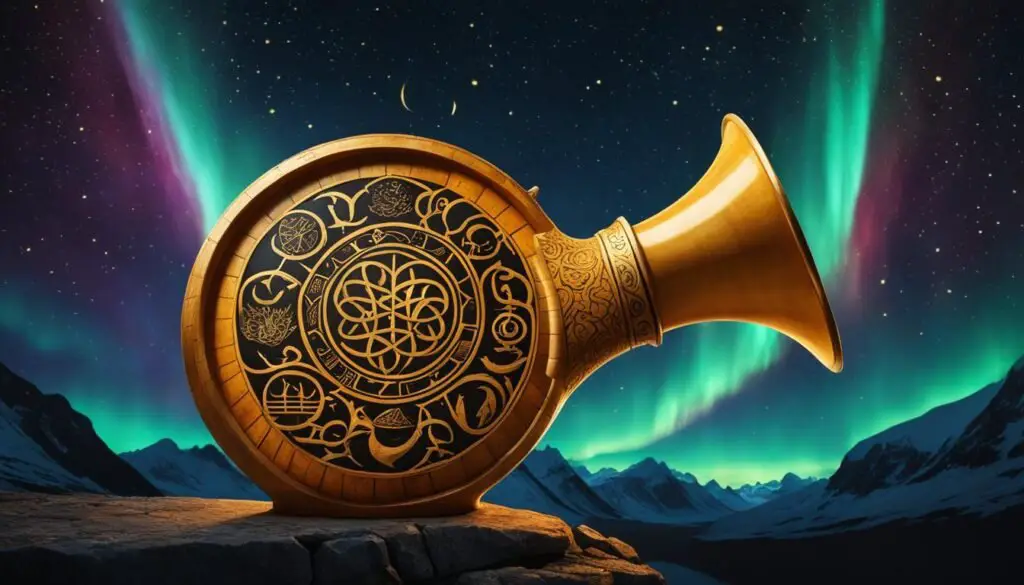In Norse mythology, mead holds a special place as a divine beverage associated with wisdom and poetic inspiration. It is often referred to as the “Mead of Poetry” or “Mead of Suttungr.” This mythical drink grants the drinker the ability to become a scholar or skald, capable of reciting any information and solving any question. The origins of mead are connected to the story of a wise man named Kvasir and his blood, which was mixed with honey by two dwarves, Fjalar and Galar, to create this magical elixir. The mead of poetry serves as a metaphor for poetic inspiration and insight, closely linked to the god Odin and the pursuit of knowledge in Norse culture.
Key Takeaways:
- Mead is a divine beverage in Norse mythology, associated with wisdom and poetic inspiration.
- Referred to as the “Mead of Poetry” or “Mead of Suttungr,” it grants the ability to become a scholar or skald.
- Originates from the story of Kvasir, a wise man whose blood was mixed with honey to create mead.
- Mead signifies poetic inspiration and insight, closely linked to the god Odin in Norse culture.
- The pursuit of knowledge is represented through the metaphoric qualities of mead in Norse mythology.
The Role of Mead in Norse Mythology
Mead in Norse mythology goes beyond being a mere beverage; it symbolizes the divine source of wisdom and poetic inspiration. It represents a connection to the gods and their realms, as well as the ability to tap into the knowledge and creative powers associated with poetic expression. The Mead of Poetry is often portrayed as a transformative drink, granting those who consume it the gift of eloquence and the ability to compose beautiful and insightful verses. It is through the consumption of mead that individuals can enter the realm of mythology itself, becoming vessels for the gods’ divine inspiration.
According to Norse folklore, mead has powerful associations with the world of poetry and inspiration. It is considered the “Mead of Poets,” a drink that enhances creativity and connects mortals to the divine realms. Drinking the mead allows individuals to channel the wisdom of the gods and become skilled in the art of storytelling and verse. This notion of mead as a vehicle for inspiration is deeply ingrained in Norse culture and mythology.
The Mead of Poetry holds a prominent place in Norse mythology. It is believed to have originated from the blood of the wise man Kvasir, which was mixed with honey by the dwarves Fjalar and Galar. This enchanted elixir bestowed the power of poetic and scholarly prowess on those who consumed it. It is said that the god Odin himself went to great lengths to obtain the Mead of Poetry, illustrating its immense value and significance in Norse mythology.
In Norse culture, mead represents more than just a beverage; it embodies the essence of inspiration and a deep connection to the divine. It is the elixir that allows mortals to tap into the wisdom and creative energy of the gods, transforming them into vessels of poetic expression. The Mead of Poetry is a testament to the importance of storytelling, knowledge, and the pursuit of inspiration in Norse mythology.
Mead in Norse Culture and Society

In Norse culture, mead held great cultural and social significance. It was not just a drink for special occasions; it played a central role in forging social bonds and fostering a sense of community.
Mead was shared during gatherings, feasts, and celebrations, serving as a symbol of hospitality, unity, and camaraderie. It was often consumed in mead halls, communal spaces where people came together to celebrate victories, honor fallen warriors, and strengthen social ties.
The act of drinking mead was seen as a way to honor Norse traditions and connect with the gods, reflecting the deep-rooted cultural importance of this divine beverage.
Mead in Norse Mythology Tales
Mead plays a significant role in various tales from Norse mythology, capturing the imagination with its magical qualities and transformative power. One such tale revolves around the creation of the Mead of Poetry, a coveted elixir that grants those who drink it the gift of divine wisdom and inspiration.
The Creation of the Mead of Poetry
According to Norse lore, Fjalar and Galar, two cunning dwarf brothers, sought to create the Mead of Poetry. To achieve this, they devised a plan to capture Kvasir, a wise man known for his immense knowledge and eloquence. The brothers killed Kvasir, taking his blood and mixing it with honey. This combination created the fabled Mead of Poetry, infused with his wisdom and intellect.
The Mead of Poetry became more than just a drink; it held the power to unlock the poetic abilities and scholarly prowess of those who consumed it.
The Tale of Suttungr and Odin’s Deception
Another prominent tale surrounding mead in Norse mythology revolves around Suttungr, who inherited the Mead of Poetry and guarded it closely. Suttungr concealed the mead within a mountain, protected by his daughter, Gunnlöd.
Despite the perilous challenge of retrieving the coveted mead, Odin, the All-Father and god of wisdom, was determined to access its transformative powers. Disguising himself as the mysterious Bölverk, Odin managed to trick the unsuspecting Suttungr, stealing the Mead of Poetry from its guarded resting place.
Odin successfully brought the mead back to the gods and shared it with worthy mortals, forever connecting them to the realms of divine wisdom and inspiration.
These tales highlight the central role of mead in Norse mythology, portraying it as an elixir that holds the power of transformation, connecting mortal beings with the divine. The Mead of Poetry becomes a symbol of the quest for knowledge, the pursuit of eloquence, and the eternal link between gods and humanity.
Mead in Viking Age and Medieval Literature

The significance of mead extended beyond mythology and played a role in Viking Age and medieval literature. One notable example is the epic poem Beowulf, which frequently references mead halls and the consumption of mead during feasts. Mead is used as a symbol of camaraderie and social unity, reflecting the cultural importance of communal gatherings in Norse society. Additionally, the Norse Eddas, both Poetic and Prose, contain myths and stories related to mead, further highlighting its role in shaping the cultural and literary landscape of the time.
Historical Development and Geographical Spread of Mead

Mead, a beverage with a rich history and cultural significance, has been enjoyed in various parts of the world throughout different time periods. In Europe, mead was closely tied to Norse and Viking cultures, particularly in Scandinavian regions like Norway and Iceland. During festive occasions and social gatherings, mead would be brewed and consumed, bringing people together in celebration.
The historical development and spread of mead can be traced back to the early Germanic tribes who introduced mead-making techniques and traditions to the Scandinavian regions. These tribes recognized the value of honey and its potential to create a delicious and intoxicating drink.
Outside of Europe, mead has also made its mark in other cultures. For instance, in Asia, China boasts a longstanding tradition of mead production dating back thousands of years. In the vast continent of Africa, Ethiopia stands out as a country with a vibrant mead culture, where a honey wine known as tej is widely enjoyed.
The geographical spread of mead showcases its appeal and versatility across different cultures. It has transcended borders, becoming a beloved and cherished beverage in diverse parts of the world. From the ancient Norse and Viking civilizations to the far reaches of Asia and Africa, mead continues to captivate and delight people with its unique flavors and cultural significance.
Symbolism and Connotations of Mead

In Norse culture, mead carries deep symbolism and connotations beyond its physical properties. It represents divine wisdom and the creative powers of poetic inspiration. Mead is seen as a bridge between the mortal and the divine, connecting individuals to the gods and their realm. It symbolizes the pursuit of knowledge, the importance of storytelling, and the preservation of cultural traditions.
Additionally, mead is associated with celebrations, feasting, and the forging of social bonds. The act of sharing and consuming mead is seen as a way to strengthen relationships, foster unity, and honor the cultural heritage of the Norse people.
- Mead as a bridge between mortals and the divine
- Symbolizes the pursuit of knowledge and poetic inspiration
- Importance of storytelling and cultural preservation
- Association with celebrations, feasting, and social bonding
- Strengthens relationships and fosters unity
Mead epitomizes the essence of Norse culture, embodying the rich symbolism and traditions cherished by the Norse people. Its status as a divine drink and its symbolic significance in Norse mythology have transcended time and continue to be celebrated and revered in modern times.
Mead in Modern Times

While mead has a rich historical and mythological legacy, it has experienced a resurgence in modern times. Meaderies around the world, including in the United States, have revived the art of mead-making and introduced innovative flavors and styles. Craft mead is now appreciated by enthusiasts who seek to explore the historical and mythical roots of this ancient beverage.
Mead festivals and gatherings have also risen in popularity, providing platforms for mead enthusiasts and producers to come together and celebrate this unique drink. These events showcase the diverse range of meads available today, from traditional honey-based meads to experimental concoctions infused with fruits, spices, and even hops. Enthusiasts can sample different flavors, learn about modern mead production techniques, and connect with like-minded individuals who share a passion for this ancient elixir.
The resurgence of mead highlights its enduring appeal and its ability to connect people to ancient traditions and folklore. It blends the old with the new, preserving the rich history and cultural significance of mead while embracing innovation and experimentation. Whether enjoyed as a standalone drink or used as a base for creative cocktail creations, mead continues to captivate the taste buds and imaginations of those who appreciate its unique qualities.
The Future of Mead in Norse Mythology

As interest in Norse mythology and ancient cultures continues to grow, so does the fascination with mead and its mythological associations. Mead has transcended the boundaries of ancient stories and become a medium through which people can explore and connect with Norse culture in modern times.
The future of mead holds immense potential for innovation, as mead producers embrace new flavors, ingredients, and brewing techniques. This resurgence in mead-making opens up exciting possibilities for enthusiasts and connoisseurs to discover unique and tantalizing blends that pay homage to the ancient tradition of mead.
Furthermore, the revival of mead-making provides an incredible opportunity to learn from historical methods and traditions, ensuring the preservation and appreciation of this ancient and magical drink. By studying the techniques employed by our ancestors, we can create a meaningful connection to the past and honor the rich cultural heritage associated with mead.
In modern Norse culture, mead continues to gain prominence as it bridges the gap between myth and reality. Mead festivals and gatherings are becoming more popular, uniting mead enthusiasts and producers in their shared passion for this extraordinary elixir. These events not only showcase the diversity and creativity within the mead-making community but also serve as platforms for exchanging knowledge and preserving the traditions that have shaped mead throughout history.
The future of mead in Norse mythology lies in the hands of those who recognize its significance and are committed to its continued celebration. By embracing the ancient traditions, fostering innovation, and nurturing a sense of community, mead will undoubtedly remain a beloved symbol of Norse culture for generations to come.
Conclusion
Mead holds a prominent place in Norse mythology, representing more than just a beverage. It embodies divine wisdom, poetic inspiration, and cultural traditions that connect mortals to the gods. The Mead of Poetry, with its mythical qualities, symbolizes the pursuit of knowledge and the power of storytelling that transcends mortal realms. Throughout history, mead has served as a catalyst for celebrating victories, forging alliances, and strengthening social bonds.
In modern times, mead continues to captivate the imaginations and palates of enthusiasts, preserving ancient traditions and providing a tangible link to Norse mythology and culture. Its resurgence in meaderies around the world reflects the enduring appeal of this magical elixir. Craft mead and innovative flavors showcase the evolving nature of mead-making, combining historical methods with contemporary techniques.
As interest in Norse mythology and ancient cultures grows, mead’s popularity is bound to rise. It not only offers a taste of the past but also provides an opportunity to explore and connect with Norse traditions. Whether sipped in commemorative gatherings or savored for its mythical associations, mead remains a testament to the enduring power of a divine drink.
FAQ
What is the significance of mead in Norse mythology?
Mead holds a special place in Norse mythology as a divine beverage associated with wisdom and poetic inspiration. It is often referred to as the “Mead of Poetry” or “Mead of Suttungr.” This mythical drink grants the drinker the ability to become a scholar or skald, capable of reciting any information and solving any question.
How was mead created in Norse mythology?
According to Norse mythology, mead was created by two dwarves, Fjalar and Galar, who mixed the blood of the wise man Kvasir with honey. This magical elixir became known as the Mead of Poetry and is closely linked to Odin, the god of wisdom and poetry.
How does mead connect mortals to the divine in Norse mythology?
Mead is seen as a bridge between mortals and the gods in Norse mythology. It represents a connection to the divine realms and the ability to tap into the knowledge and creative powers associated with poetic expression. Drinking mead grants individuals the gift of eloquence and the ability to compose beautiful and insightful verses.
What role did mead play in Norse culture and society?
In Norse culture, mead held great cultural and social significance. It was not just a drink for special occasions but played a central role in forging social bonds and fostering a sense of community. Mead was shared during gatherings, feasts, and celebrations, serving as a symbol of hospitality, unity, and camaraderie.
What are some tales from Norse mythology involving mead?
In Norse mythology, there are several tales involving mead. One such tale involves Fjalar and Galar, two dwarf brothers who mixed the blood of the wise man Kvasir with honey to create the Mead of Poetry. Another tale revolves around Suttungr, who guarded the mead until Odin, disguised as Bölverk, tricked him and stole it.
How did mead feature in Viking Age and medieval literature?
Mead is prominently featured in Viking Age and medieval literature. The epic poem Beowulf frequently references mead halls and the consumption of mead during feasts. Additionally, the Norse Eddas, both Poetic and Prose, contain myths and stories related to mead, showcasing its role in shaping the cultural and literary landscape of the time.
What is the geographical spread of mead?
Mead has a rich history and geographic spread across various cultures throughout history. It is closely associated with Norse and Viking cultures in Europe, particularly in Scandinavian regions such as Norway and Iceland. Mead has also been found in other parts of the world, including Asia, where China has a long-standing tradition of mead production. It is also enjoyed in Africa, particularly in Ethiopia, where a honey wine known as tej is popular.
What does mead symbolize in Norse culture?
Mead symbolizes divine wisdom and the creative powers of poetic inspiration in Norse culture. It represents the pursuit of knowledge, the importance of storytelling, and the preservation of cultural traditions. Additionally, mead is associated with celebrations, feasting, and the forging of social bonds.
How has mead evolved in modern times?
Mead has experienced a resurgence in modern times. Meaderies around the world have revived the art of mead-making and introduced innovative flavors and styles. Craft mead is now appreciated by enthusiasts who seek to explore the historical and mythical roots of this ancient beverage. Mead festivals and gatherings have also risen in popularity, providing platforms for mead enthusiasts and producers to come together and celebrate this unique drink.
What does the future hold for mead in Norse mythology and culture?
As interest in Norse mythology and ancient cultures continues to grow, so does interest in mead and its mythological associations. The future of mead holds the promise of continued innovation, with mead producers experimenting with new flavors, ingredients, and brewing techniques. The revival of mead-making also presents an opportunity to learn from historical methods and traditions, ensuring the preservation and appreciation of this ancient and magical drink.
What is the significance of mead in Norse mythology?
Mead holds a prominent place in Norse mythology, symbolizing divine wisdom, poetic inspiration, and cultural traditions. It is a beverage that connects mortals to the gods and serves as a catalyst for celebrating victories, forging alliances, and strengthening social bonds. The Mead of Poetry, with all its mythical qualities, represents the pursuit of knowledge, the power of storytelling, and the ability to tap into the divine realms. In modern times, mead continues to captivate people’s imaginations and palates, preserving ancient traditions and providing a link to Norse mythology and culture.




